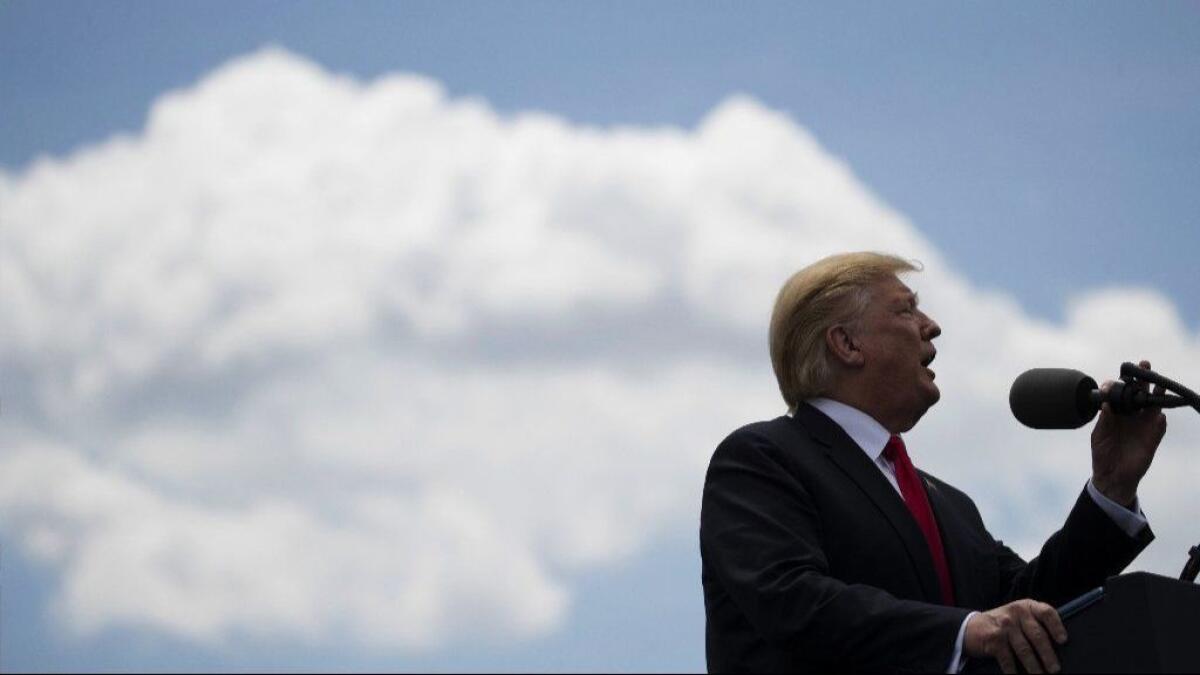Trump’s promised Mexico tariffs appeal to his base but pose a big political risk in 2020

Reporting from Washington — President Trump’s dramatic threat to slap tariffs on all Mexican imports until Mexico does more to block migrants from entering the U.S. sends a powerful message to his political supporters, bringing together his signature nationalist issues of trade and immigration in one bombshell initiative.
But if the sharply escalating tariffs are imposed, it could pose a major political risk to Trump in the 2020 race and to one of his top legislative priorities, a revised North American trade agreement.
Economists say the steep and broad tariffs on America’s third-largest trading partner could rattle the U.S. economy, whose strength is one of Trump’s most important political assets in his reelection bid. Stock markets fell broadly around the world Friday, with the Dow Jones industrial average dropping 354 points, or 1.41%.
“The biggest thing Trump has in his favor going into reelection is the economy,” said Matt Gorman, a Republican strategist who was spokesman for the House GOP campaign committee in the 2018 midterm elections. “Anything that jeopardizes the economy jeopardizes his chances.”
Mexico’s Foreign Minister Marcelo Ebrard rushed to Washington late Friday after talking by phone with U.S. Secretary of State Michael R. Pompeo and Trump’s son-in-law and senior advisor Jared Kushner, both of whom are in Switzerland. In a tweet, Ebrard said he would meet a U.S. delegation led by Pompeo on Wednesday, five days before the first 5% tariff is due to kick in.
President Andres Manuel Lopez Obrador said he hoped “dialogue” could resolve the standoff.
The tariff threats come amid mounting frustration at the White House as near-record numbers of Central American families and asylum seekers have surged to the southern border, defying the administration’s aggressive deterrence and enforcement efforts.
Trump also acted after activists who support his anti-immigration policies widely criticized a recent White House proposal, largely crafted by Kushner, that did not seek to lower legal immigration levels, as hard-liners had demanded.
One administration official suggested the tariffs on Mexico would help the president with those activist critics. “He looks strong to them again,” the official said.
White House Press Secretary Sarah Huckabee Sanders previewed the political argument on Friday, casting Democrats and even some Republican members of Congress as unwilling to join him in making the tough decisions required to fix what he has called a border crisis.
“The president’s the only one who’s actually stepping up and putting forward things to stop it,” she said.
Asked about the latest stock market drop and the potential for further economic fallout, Sanders hinted at the administration’s hope that Trump can find agreement with Mexico before the tariff deadline.
“Mexico should engage with us and we wouldn’t have to take any additional steps, but at the same time, the No. 1 duty that the president has is national security and to protect Americans,” she said.
Another White House official said the initiative was the culmination of two days of intense discussions among Cabinet officials and domestic White House staff, including meetings Thursday, when the president was on Air Force One to and from the graduation ceremony for the Air Force Academy in Colorado Springs, Colo.
The official would not say who came up with the escalating tariffs, but agreed Trump was “delighted when he was made aware” that he could fuse his top two issues — trade and immigration.
“This is what grabs the lapels of these people who don’t think we have a crisis at the border,” the official said.
Trump made the surprise announcement after stock markets had closed Thursday, vowing to impose a 5% tariff on all Mexican imports starting June 10, rising steadily to 25% by October, until Mexico “substantially stops the illegal inflow of aliens.”
“If the illegal migration crisis is alleviated through effective actions taken by Mexico, to be determined in our sole discretion and judgment, the tariffs will be removed,” Trump said, giving himself a mile-wide loophole to decide whether to proceed or not.
Trump has issued dire threats in the past and then pulled back. Whether he intended the tariffs as a negotiating ploy, or actually plans to disrupt billions of dollars of cross-border trade with Mexico, is an open question, especially given sharp blowback from Republicans in Congress and on Wall Street.
Sen. Patrick J. Toomey (R.-Pa.), a strong free-trade advocate, said the White House tariff proposal is “the wrong remedy” to the security and humanitarian needs on the border because it would raise costs to U.S. consumers for cars, agriculture and other critical goods made or processed in Mexico..
“The president’s use of tax hikes on Americans as a tool to affect change in Mexican policy is misguided,” he said Friday.
The White House plan gave pause even to Senate Majority Leader Mitch McConnell (R-Ky.), who rarely parts ways with Trump in public.
“A healthy and vibrant economic relationship with Mexico is a vital source of our joint prosperity,” McConnell said. “Any proposal that impacts this relationship deserves serious examination and I look forward to discussing this plan in greater detail with my colleagues and the administration.”
A more immediate risk is that the escalation of border and trade tensions could scuttle the revised North American Free Trade Agreement — known as USMCA — that is awaiting approval in Congress and in Mexico’s Legislature.
Its approval was shaping up as a major economic policy accomplishment for Trump, who had campaigned on the issue. His administration spent a year trying to renegotiate the deal with Canada and Mexico.
“By jeopardizing USMCA, he further hurts Midwest farm producers already battered by the China trade war and potentially results in the exact opposite of what he is trying to do,” said G. William Hoagland, a former Senate GOP advisor who is senior vice president of the Bipartisan Policy Center, a Washington-based think tank. “By hurting the Mexico economy, it increases migration to the U.S.”
In March, Trump threatened to close the entire U.S.-Mexico border, only to retreat under intense pressure, claiming Mexican authorities had agreed to do more to stop the immigrant surge. He ended up saying he would give Mexico a year to demonstrate progress before imposing tariffs on automobiles.
Trump defied skeptics and carried out his threats to slap tariffs on about $250 billion in imported goods from China. On Saturday, Chinese retaliatory tariffs will take effect on about $60 billion of goods imported from the United States as the trade war deepens between the world’s two largest economies.
Business leaders who are usually strong Republican allies are taking the Mexican-tariff threat seriously and reacting with alarm.
The U.S. Chamber of Commerce, the business lobbying group, calculates that a 5% tariff on Mexican imports would cost consumers and businesses $17.3 billion annually, rising to $86.6 billion if the tariff rose to 25% this fall.
In California alone, it would cost $2.2 billion under the 5% tariff and $11 billion at 25%.
Neil Bradley, the chamber’s executive vice president, said the group’s officials are pursuing legal and legislative options for blocking the tariffs in case they cannot dissuade Trump from pursuing a policy that business leaders believe could undercut recent economic gains.
“The president and [Congress] deserve credit for what they have done to remove other wet blankets on the economy, but if you impose new wet blankets, there is no question that is going to hurt their political prospects,” Bradley said.
The strategy illustrates how strongly immigration dominates Trump’s view of the electoral mandate he received in 2016.
“Perhaps more than any other issue, our 2016 movement energized around regaining sovereignty over our borders,” said Steve Cortes, a Trump campaign co-chair at the time, who saw immigration as central to Trump’s promise to Make America Great Again. “In recent months, the situation there spiraled into chaos, and those of us in the MAGA movement are thrilled that the president is taking strong action.”
Trump claims the latest moves are intended to force Mexico to stop migrants from illegally entering the U.S. — but the current surge at the southern border is made up mostly of Central American families and unaccompanied youth, many of whom are exercising a legal right to seek asylum, enshrined in U.S. law.
In fiscal 2019, which began in October, about 64% of those stopped by U.S. officials at the border — nearly 300,000 people — have been families and children traveling without an adult. Most originally came from the impoverished and violence-torn countries of Guatemala, Honduras and El Salvador.
Analysts on both sides of the border said it remained unclear what exactly Trump wants Mexico to do, noting that tariffs hurt consumers more than anything.
“It is not clear what Mexico has to do to prevent the tariffs, “ Jason Marczak, director of the Adrienne Arsht Latin America Center at the Atlantic Council, a nonpartisan think tank in Washington. “He wants to show he is being tough on immigration, and walking it back now would be terribly problematic for his reelection.”
Times staff writers Tracy Wilkinson, Molly O’Toole and Jennifer Haberkorn contributed to this report.
More stories from Janet Hook »
More to Read
Get the L.A. Times Politics newsletter
Deeply reported insights into legislation, politics and policy from Sacramento, Washington and beyond. In your inbox three times per week.
You may occasionally receive promotional content from the Los Angeles Times.













